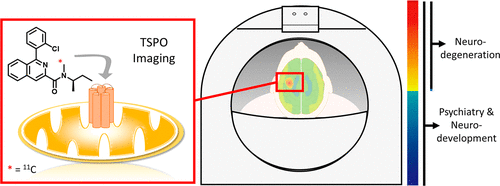当前位置:
X-MOL 学术
›
ACS Chem. Neurosci.
›
论文详情
Our official English website, www.x-mol.net, welcomes your feedback! (Note: you will need to create a separate account there.)
Tracing the History of the Human Translocator Protein to Recent Neurodegenerative and Psychiatric Imaging.
ACS Chemical Neuroscience ( IF 5 ) Pub Date : 2020-07-14 , DOI: 10.1021/acschemneuro.0c00362 Olivia M Downer 1 , Rachel E G Marcus 1 , Nicole R Zürcher 1, 2 , Jacob M Hooker 1, 2
ACS Chemical Neuroscience ( IF 5 ) Pub Date : 2020-07-14 , DOI: 10.1021/acschemneuro.0c00362 Olivia M Downer 1 , Rachel E G Marcus 1 , Nicole R Zürcher 1, 2 , Jacob M Hooker 1, 2
Affiliation

|
The human 18 kDa translocator protein (TSPO) has been widely used as a measure of glial activation in health and disease. With the continuous progress of radiotracers with increased affinity and selectivity, associations between TSPO expression, disease severity, and progression have been examined, particularly in neurodegenerative disorders such as multiple sclerosis (MS), Parkinson’s disease (PD), and amyotrophic lateral sclerosis (ALS). However, findings in psychiatric disorders have prompted reassessment of the interpretation of regional TSPO expression differences in the brain, specifically with respect to potential neuroinflammatory components. This “mini” Review aims to guide readers through the complexity of TSPO imaging research by identifying the successes, challenges, and promising new directions of the field. We will provide a brief history of how TSPO imaging has evolved over the last three decades and present lessons learned in the context of neurodegenerative and psychiatric disorders.
中文翻译:

将人类易位蛋白的历史追溯到最近的神经退行性和精神病学成像。
人类 18 kDa 易位蛋白 (TSPO) 已被广泛用作衡量健康和疾病中神经胶质激活的指标。随着具有增加亲和力和选择性的放射性示踪剂的不断进步,已经检查了 TSPO 表达、疾病严重程度和进展之间的关联,特别是在多发性硬化症 (MS)、帕金森病 (PD) 和肌萎缩侧索硬化症 (ALS) 等神经退行性疾病中)。然而,精神疾病的发现促使人们重新评估大脑中区域 TSPO 表达差异的解释,特别是关于潜在的神经炎症成分。这篇“迷你”评论旨在通过确定该领域的成功、挑战和有希望的新方向来引导读者了解 TSPO 成像研究的复杂性。
更新日期:2020-08-05
中文翻译:

将人类易位蛋白的历史追溯到最近的神经退行性和精神病学成像。
人类 18 kDa 易位蛋白 (TSPO) 已被广泛用作衡量健康和疾病中神经胶质激活的指标。随着具有增加亲和力和选择性的放射性示踪剂的不断进步,已经检查了 TSPO 表达、疾病严重程度和进展之间的关联,特别是在多发性硬化症 (MS)、帕金森病 (PD) 和肌萎缩侧索硬化症 (ALS) 等神经退行性疾病中)。然而,精神疾病的发现促使人们重新评估大脑中区域 TSPO 表达差异的解释,特别是关于潜在的神经炎症成分。这篇“迷你”评论旨在通过确定该领域的成功、挑战和有希望的新方向来引导读者了解 TSPO 成像研究的复杂性。



























 京公网安备 11010802027423号
京公网安备 11010802027423号